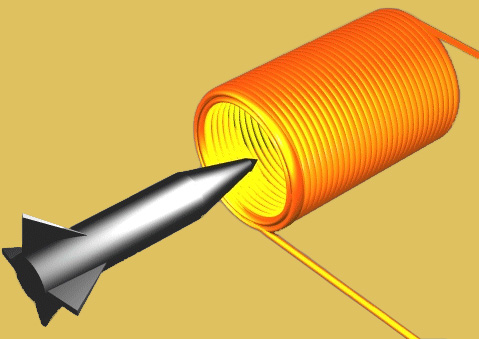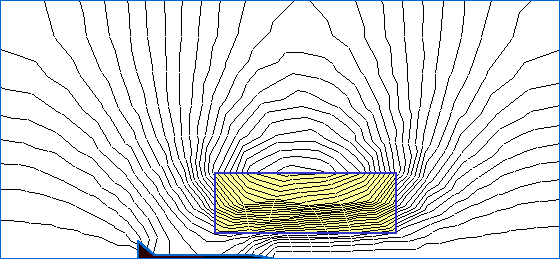
Practical Coilgun Design
Magnetic Materials
- Magnetic Materials
- Solenoid Physics
- Magnetic Field
- Force From Magnetism
- Saturation
- Saliency Ratio
- Salient Pole Motors
- Electromagnetic Guns
- Widescreen LCD
- IEEE Articles
- Bibliography
Magnetic Field
What is it about a screw that makes it a superior projectile? If a magnetic field affects a projectile, then how does the projectile affect the magnetic field? Exactly how do those magnetic flux lines get engaged with the screw?
QuickField
To investigate this, I modeled my coilgun and projectile in the student edition (free! get it!) of QuickField v4.1. You can download my compressed QuickField files, MyCoil1.zip. The dimensions of my model match my actual coilgun. It contains three files used by QuickField:
- MyCoil1.pbm - the "problem file"
- MyCoil1.mod - the "model file"
- MyCoil1.dms - the "data file"
Magnetic Field Plot
The view below is a cross section of the coil and screw. Why is it only half there? Because of symmetry. Imagine a mirror along the bottom of the image below. The bottom half is identical to the top half. QuickField takes advantage of this to simplify and speed up its calculations. QuickField calls this "axial symmetry" because all parts are rotated in 3D around a single axis along the bottom of the figure, forming a complete screw and a complete hollow cylinder for a coil.
The yellow square block is cylinder of the coil, sliced in half. All its wires are going into the page. The other half of the coil is not shown -- all its wires are coming out of the page toward you.
The black item on the bottom of the image above is the screw, sliced in half.
What follows below is my lame attempt to explain magnetism. This is really non-scientific, but I hope it gives some insight into why solenoids work, using layman's terms. Please clue me in if I've got something wrong, or if I might explain things better.
Field Flux Animation
The figure above has been animated (274K) to show how the magnetic flux lines change while the screw is gradually moved closer toward the middle of the coil. Click here (or on the picture above) to watch the animation.
What are these magnetic flux lines? The flux lines link the North poles to the South poles of a magnet. They are imaginary lines showing the path of magnetism. For example, if you sprinkle iron filings into a magnetic field, they align themselves with the magnetic flux lines.
While you watch the animation, think about these characteristics of magnetic fields.
- Flux lines want to be as short as possible. They just love to go through iron, because iron works something like a low-resistance path for electrons. It provides a guide for the magnetic field, rather like wires provide a guide for electrons.
- Flux lines repel each other; they want to spread out from other flux lines as much as possible. Whether in free space, air or iron, the flux lines spread out to fill all possible space.
All the interesting effects of magnetism used by modern machinery arise from these two opposing tendencies. The flux lines always align themselves to balance these tendencies. Devices exploit them by arranging magnetic guides (iron) and magnetic sources (coils or magnets) to get some desired effect. Pieces of iron are attracted to magnet because the flux lines want to be as short as possible. Magnetic forces work over a distance because the flux lines want to spread out from each other as much as possible.
Field Strength
Want to know the exact strength of the magnetic field? Here's an equation for an air-filled coil, as seen along the center axis. Go see "axial field of a finite solenoid".
Please note it doesn't apply to a coil with a projectile in it, because it would no longer be "air filled".
| < Previous | Page 3 of 11 | Next > |
©1998-2025 Barry Hansen
